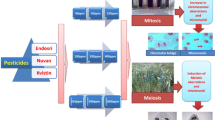Abstract
In this study, the genotoxicity of commonly used insecticide cypermethrin and fungicide carbendazim were examined on root meristem cells of Hordeum vulgare L. Cypermethrin and carbendazim were applied with concentrations of 0.05%, 0.1% and 0.5% at different presoaking durations of 7 h, 17 h and 27 h which falls into G1, S and G2 phases of cell cycle, respectively. The cytogenetic studies of the root meristem cells of Hordeum vulgare L. showed that S phase of the cell cycle was more sensitive in comparison to other phases of cell cycle.
Similar content being viewed by others
References
Advisory Committee on Pesticides (1992) Evaluation on carbendazim, evaluation of fully approved or provisionally approved products, No. 58. Ministry of Agriculture, Fisheries and Food
El-Ghamery AA, El-Nahas AI, Mansour MM (2000) The action of atrazine herbicide as an inhibitor of cell division on chromosomes and nucleic acid content in root meristems of Allium cepa and Vicia faba. Cytologia 65:277–287
Grant WF (1982) Chromosome aberrations assay in Allium. A report of USEPA Gene tox. programme. Mutat. Res. 99:273–291
Hicks B (1998) Generic pesticides – the products and markets, Agrow reports. PJB Publications
Klasterska I, Natrajan AT, Ramel C (1976) An interpretation of the origin of subchromatid aberrations and chromosome aberrations and chromosome stickiness as a category of chromatid aberrations. Hereditas 83:153–162
Permjit K, Grover IS (1985) Cytological effects of some organophosphorus pesticides. II Meiotic effects. Cytologia 50:199–211
Quian Y (1996) Transformation and expression of the resistance gene to carbendazim into Trichoderma harzianum. Resist Pest Manage 6:8–12
Reigart J (1999). Recognition and management of pesticide poisonings. EPA
Saxena PN, Chauhan LKS, Gupta SK (2005) Cytogenetic effects of commercial formulation of cypermethrin in root meristem cells of Allium sativum: spectroscopic basis of chromosome damage. Toxicology 216:244–252
Schneidermann MH, Dewey WC, Highfield DP (1971) Inhibition of DNA synthesis in synchronized chinese hamster cell treated in G1 with cycloheximide. Exp Cell Res 67:147–155
Singh P, Srivastava AK, Singh AK (2007) Comparative sensitivity of barley (Hordeum vulgare L.) to insecticide and fungicide on different stages of cell cycle. Pestic Biochem Physiol 89:216–219
Srivastava AK, Singh P (2007) Plant bioassay: method for assessment of genotoxicity. Environ Sci (An Indian Journal) 2:98–102
Sudhakar R, Ninge Gowda KN, Venu G (2001) Mitotic abnormalities induced by silk dyeing industry effluents in the cells of Allium cepa. Cytologia 66:235–239
Tomkins DJ, Grants WF (1972) Comparative cytological effects of pesticides: menazon metrobromuron and tetrachloro isophthalonitrile in H. vulgare and Tradescantia. Can J Gen Cytol 14:245–256
Author information
Authors and Affiliations
Corresponding author
Rights and permissions
About this article
Cite this article
Singh, P., Srivastava, A.K. & Singh, A.K. Cell Cycle Stage Specific Application of Cypermethrin and Carbendazim to Assess the Genotoxicity in Somatic Cells of Hordeum Vulgare L. Bull Environ Contam Toxicol 81, 258–261 (2008). https://doi.org/10.1007/s00128-008-9469-7
Received:
Accepted:
Published:
Issue Date:
DOI: https://doi.org/10.1007/s00128-008-9469-7




